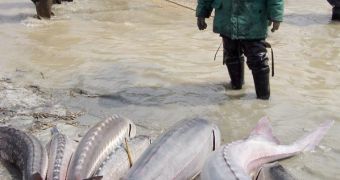This is the strangest sea in the world. It is not even a real sea, but the largest lake in the world by area: the Caspian Sea measures 371,000 square km (143,244 square mi), almost as much as California and is located between Europe and Asia. But this lake is salty, even if its salt concentration represents just one third of that of the ocean.
The Caspian Sea emerged 30 million years ago from the Sarmatic Sea, which was a rest of the Tethys Ocean. About 5.5 million years ago the Caspian Sea became a landlocked body of water. It now behaves both like a sea and a lake. Its basin is closed, without any connection with the ocean. It is mainly fueled by the Volga River (80% of the inflow), which is also the largest European river, and the Ural River, but it cannot discharge its supplementary water levels in other way than evaporation.
That's why this sea displays an extremely strange phenomenon: its levels fall and rise naturally, often rapidly, over the centuries.
By 2004, the Caspian water level was 28 metres (92 feet) below the ocean level. It may seem curious, but in fact its levels depend greatly on cycles of the atmospheric conditions of the North Atlantic, very far away from its location. But this determines the rainfall on Volga's huge basin.
These conditions turn the Caspian Sea into a valuable barometer of the impact of global climate change.
From 1929 to 1977, the sea level fell off 3 m (10 ft). Increased salinity was menacing the fish fauna (especially the caviar-bearing sturgeons, in which this sea is extremely rich). Many plans were made during this period on how to save the sea: a connection with the Arctic Ocean, a channel between the Azov Sea and Caspian Sea, heading waters from Don or Dnieper Rivers (which flows in the neighboring Black Sea and Azov Sea).
But after that, natural changes in the clime of the northern Atlantic induced a natural rise of 3 m from 1977 until 1995, provoking major environmental problems and havoc on coastal infrastructure, flooded residential areas, transport, telecommunications and energy infrastructure, chemical and petrochemical industries, croplands and hatcheries.
In Turkmenistan, the town of Dervish is turning into an island. The rising waters have provoked oil pollution on extraction zones. At the onshore Tengiz oil field (Kazakhstan), over 100 wells have been flooded and roughly 1,200 wells are at risk.
The sea-level rise affects water regime, hydrochemistry of river mouths, structure and productivity of biological communities, pollution by heavy metals, synthetic substances, radioactive isotopes and other substances.

 14 DAY TRIAL //
14 DAY TRIAL //